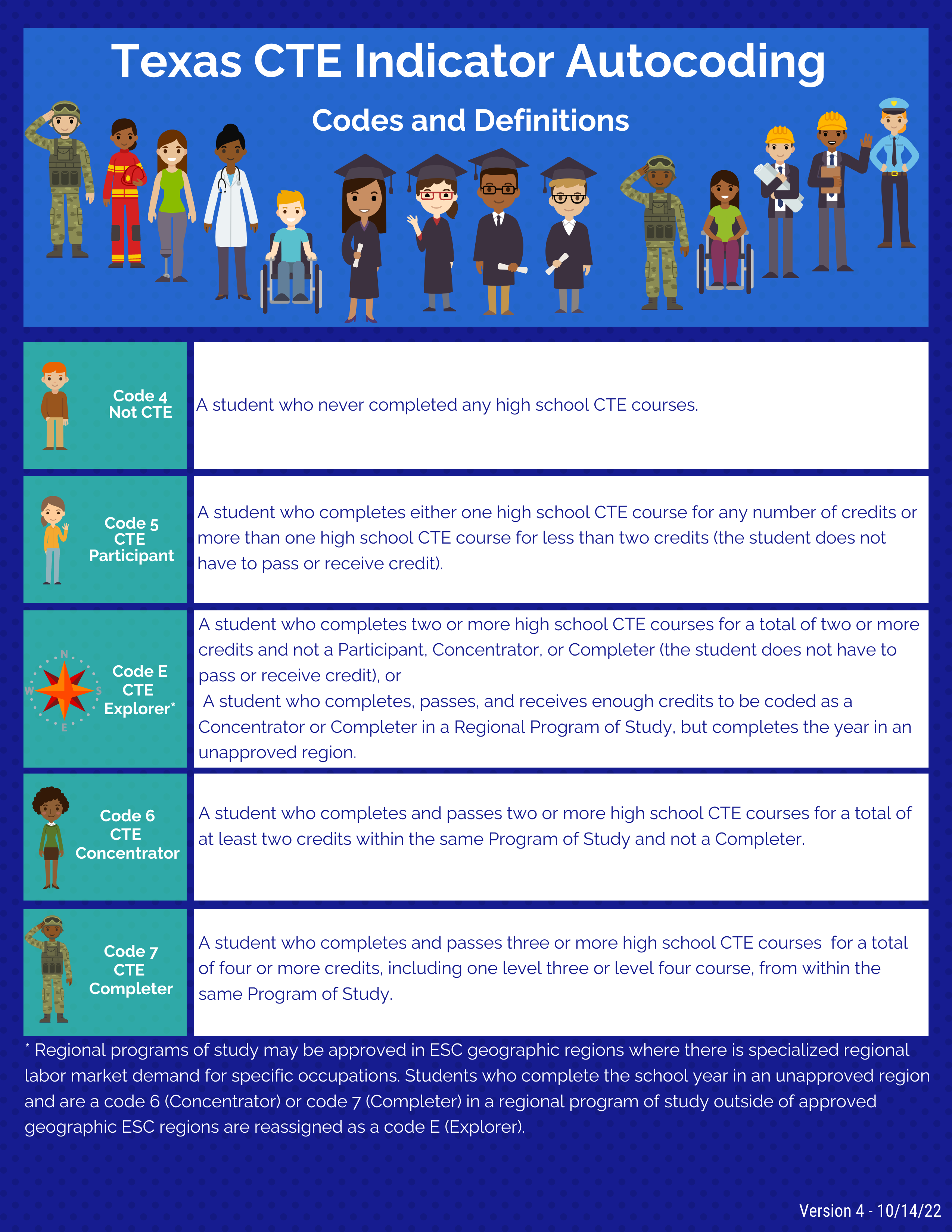Perkins V
2024-2025 Comprehensive Local Needs Assessment Guidebook
One of the most significant changes introduced in the Strengthening Career and Technical Education for the 21st Century Act (Perkins V) is the comprehensive local needs assessment (CLNA). The law states local eligible recipients must complete a comprehensive local needs assessment related to career and technical education once every two years. The 2024-2025 CLNA (SC5600) is required for local education agencies (LEAs) applying for 2024-2025 Perkins funding. The CLNA guidebook is designed to assist Texas LEAs with the completion of the local needs assessment. The local needs assessment process is intended to be a regular part of a LEA's data-driven decision making and program improvement system.
- CLNA Guidebook (2024-25)
- WDA Labor Market Information 2021-2031 (updated 12/05/2023)
Perkins V State Plan
On July 31, 2018, the president signed the Strengthening Career and Technical Education for the 21st Century Act (Perkins V) into Law. Perkins V includes key changes that will impact the implementation of CTE programs, such as an added emphasis on programs of study, the addition of a Comprehensive Local Needs Assessment, and the introduction of new program quality indicators. The Texas Perkins V four-year state plan, covering all of the requirements of the Act, will be submitted to the US Department of Education upon approval by the Governor and State Board of Education in spring 2020.
The full plan can be viewed here:
- Perkins V State Plan 2024-2028 (Updated Oct 2024)
- Perkins V Executive Summary (PDF)
- Perkins V Overview Presentation (PPT)
Help Wanted Online-Employment Information for Secondary School Students
Find more information at:
Autocoding Information
The transition from self-reported data to an autocoded course completion system reported in PEIMS is effective for the 2020-2021 school year. The Perkins V Indicator report is generated from this data set to measure the performance of CTE programs in Texas at the local and state levels. The following resources will provide local education agencies (LEA) and stakeholders with information on the new autocode system. LEAs interested in developing a local version of the CTE autocode system can access the technical documents at PEIMS Calculation Tech Tips (updated for 2022-23) under CTE auto calculation.
Texas CTE Indicator Autocoding Codes and Definitions
Code 4 Not CTE
A Student who never completed any high school CTE courses.
Code 5 CTE Participant
A student who completes wither one high school CTE course for any number of credits or more than one high school CTE course for less than two credits (the student does not have to pass or receive credit).
Code E CTE Explorer*
A student who completes two or more high school CTE courses for a total of two or more credits and not a Participant, Concentrator, or Completer (the student does not have to pass or receive credit), or A student who completes, possess, and receives enough credits to be coded as a Concentrator or Completer in a Regional Program of Study, but completes the year in an unapproved region.
Code 6 CTE Concentrator
A student who completes and passes two or more high school CTE courses for a total of at least two credits within the same Program of Study and not a Completer.
Code 7 CTE Completer
A student who completes and passes three or more high school CTE courses for a total of four or more credits, including one level three or level four course, from within the same Program of Study.
*Regional programs of study may be approved in ESC geographic regions where there is specialized regional labor market demand for specific occupations. Students who complete the school year in an unapproved region and are a code 6 (Concentrator) or code 7 (Completer) in a regional program of study outside of approved geographic ESC regions are reassigned as a code E (Explorer).
An Introduction to the Texas CTE Indicator Auto Code Project (Video)
Perkins V Indicator Data Statewide Report
The Perkins V Indicator Data Statewide report provides summary data on the performance of Texas secondary career and technical education (CTE) programs for school years as required by Sec. 113(C),(D), and (E) of the Strengthening Career and Technical Education for the 21st Century Act (PL 115-224, Enacted July 31, 2018), Perkins V.
- Perkins V Indicator Data Statewide Report 2018-2019
- Perkins V Indicator Data Statewide Report 2019-2020
The state-level data is disaggregated by:
- Race, Gender, and Ethnicity
- Perkins V identified Special Populations
- Federal Career Clusters
- State Career Clusters
- In the 5S4 (CTE Completers) tab – Programs of Study
The disaggregated report will open to show federally reported performance indicator:
- 1S1 – Four-Year Graduation Rate
- 1S2 – Extended Graduation Rate
- 2S1 – Academic Proficiency in Reading/Language/Arts
- 2S2 – Academic Proficiency in Mathematics
- 2S3 – Academic Proficiency in Science
- 3S1 – Post-Program Placement
- 4S1 – Non-traditional Program Concentration
- 5S1 – Program Quality – Attained Recognized Postsecondary Credential
- 5S4 – Program Quality – CTE Completer
The report is an accompaniment to the data available to local education agencies (LEAs) in Texas Education Agency Login (TEAL) system through the career and technical education report (CTER) application. Requests for access to data in the CTER application must be submitted to LEA leadership, who will forward the request to the Texas Education Agency in the TEAL system.


